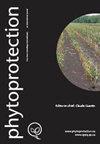Characterization of resistance to crenate broomrape (Orobanche crenata) in a new small-seeded line of Tunisian faba beans
IF 0.2
4区 农林科学
Q4 PLANT SCIENCES
引用次数: 23
Abstract
Orobanche crenata, crenate broomrape, causes major drawbacks in faba bean production in Mediterranean countries. The development of resistant varieties remains the most efficient way to solve this problem. This study was designed to assess the resistance of the breeding line XBJ90.03-16-1-1-1-1 to crenate broomrape, using cv. Bachaar as a susceptible control. Incidence and severity parameters were evaluated in infested fields to values reaching 95% and 4 (on a 1 to 9 scale), respectively, in 'Bachaar', and reaching only 5% and 1.5, in 'XBJ90.03-16-1-1-1-1'. This selected line displayed, at the most, an average of one emerged crenate broomrape individual per plant at crop maturity, whereas 'Bachaar' plants displayed five emerged broomrape individuals under the same conditions. In addition, the seed yield of 'XBJ90.03-16-1-1-1-1' plants was two-fold higher than that of 'Bachaar'. In pot experiments, number and total dry weight of broomrape individuals per plant were significantly higher for 'Bachaar' than for 'XBJ90.03-16-1-1-1-1'. In root chambers, percent germination of broomrape seeds was five-fold lower in the vicinity of 'XBJ90.03-16-1-1-1-1' roots (3%) than close to 'Bachaar' roots (15%). The direct consequence was a limited number of broomrape tubercles per 'XBJ90.03-16-1-1-1-1' plant. Furthermore, tubercle formation on 'XBJ90.03-16-1-1-1-1' roots was delayed by a week compared with the infection process on 'Bachaar' roots. Finally, some features of 'XBJ90.03-16-1-1-1-1' roots were characterized, such as the low amount of exudation of germination stimulant, which, combined with a deep root system, triggers resistance to the parasite.突尼斯蚕豆一个小种子新品系对圆齿帚状油菜(Orobanche crenata)的抗性
在地中海国家,有圆齿的帚状油菜是蚕豆生产的主要缺陷。开发抗病品种仍然是解决这一问题的最有效途径。本试验采用遗传育种方法,对XBJ90.03-16-1-1-1-1对圆齿帚花的抗性进行了评价。Bachaar作为易感对照。在“Bachaar”疫区,发病率和严重程度分别达到95%和4(1 ~ 9级),而在“XBJ90.03-16-1-1-1-1”疫区,发病率和严重程度仅为5%和1.5。这个选择的品系在作物成熟时,每株植株平均最多出现一个具圆齿的扫帚油菜个体,而“Bachaar”植株在相同的条件下显示出五个出现的扫帚油菜个体。此外,‘xbj90.03 -16-1-1-1’植株的种子产量比‘Bachaar’高出2倍。盆栽试验中,‘Bachaar’单株扫帚花个体数和总干重显著高于‘xbj90.03 -16-1-1-1’。在根室中,“xbj90.03 -16-1-1-1”根附近的油菜种子发芽率(3%)比“Bachaar”根附近的种子发芽率(15%)低5倍。直接结果是每株‘xbj90.03 -16-1-1-1’的扫帚菜瘤数量有限。与‘Bachaar’根相比,‘xbj90.03 -16-1-1-1’根的结核形成时间延迟了一周。最后,分析了‘xbj90.03 -16-1-1-1’根系的发芽刺激物分泌量低,根系较深,对寄生虫具有抗性等特点。
本文章由计算机程序翻译,如有差异,请以英文原文为准。
求助全文
约1分钟内获得全文
求助全文

 求助内容:
求助内容: 应助结果提醒方式:
应助结果提醒方式:


